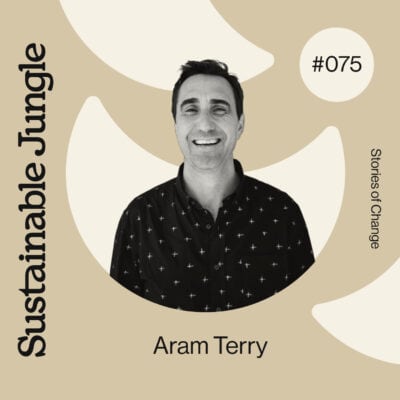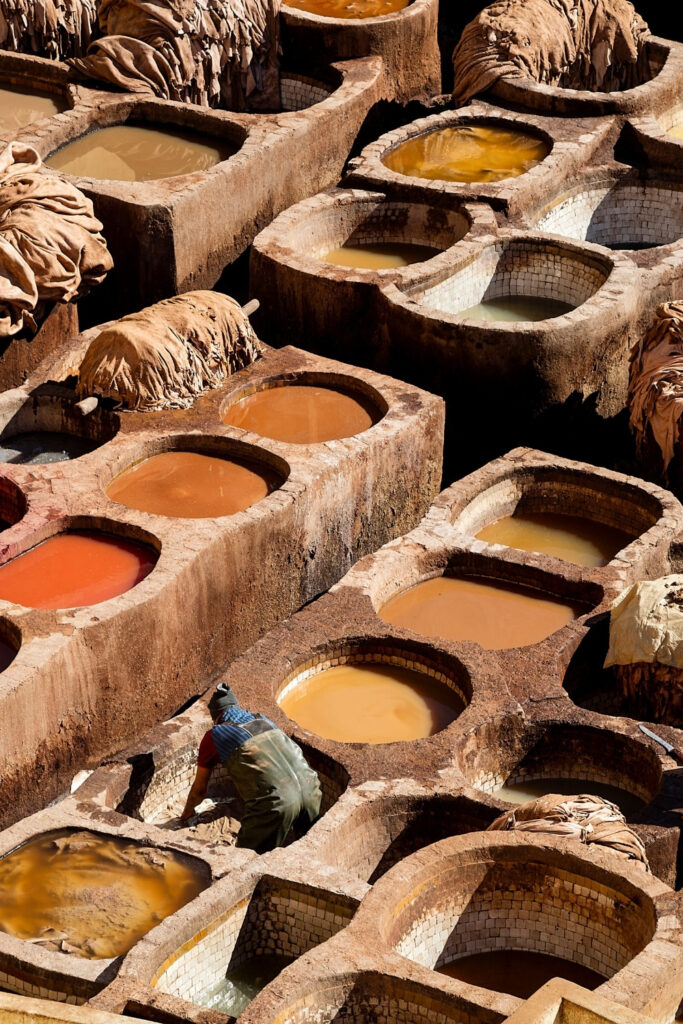How eco-friendly are sustainable dyes? Turns out it’s not so black and white—and we’re not talking about the colors.
There’s a lot to consider as far as the ecological impact of textile dyeing goes: ingredient sourcing, toxicity, water consumption, pollution, and waste. There’s also a fair amount of greenwashing going on which can leave us all feeling a little jaded.
Rather than taking a company’s claims of using “sustainable dyes” at face value, we need to ask some questions. Why are their dyes sustainable? Are they natural, non-toxic, low-impact, or fiber reactive? Or are they just azo-free? And what do those terms mean anyway?!
If you’re dyeing to find out, join us as we take a deep dyve into eco-friendly fabric dyes. We’ll discuss whether natural dyes are the way to go, if synthetic colors can ever be sustainable, and how sustainable dye technology and innovations are going for gold.
Let’s get to coloring in your know-how on the most sustainable dyes.
Contents: Eco-Friendly Dyes
- How Eco-Friendly Are Dyes? Jump to section
- What Are Sustainable Dyes? Jump to section
- Are Natural Dyes Sustainable? Jump to section
- Low Impact Dyes Vs. Natural Dyes Jump to section
- Sustainable Dye Innovations Jump to section
- Certifications For Sustainable Textile Dyes Jump to section
How Eco-Friendly Are Dyes?
The vast majority of dyes used today are synthetic—coloring about 90% of our clothing and home textiles. They’re made from petrochemicals, which is bad news for the environment and the people and animals exposed to it.
Water Consumption & Pollution
First, conventional dyeing is a water-intensive process. It takes about 125 liters of water to dye a mere kilogram of cotton.
Worse, textile dyeing and finishing are responsible for ~20% of global water pollution, making the fashion industry the world’s second-largest water polluter. When toxic chemicals from the dyeing process—including heavy metals, dioxins, and formaldehyde—enter waterways, they kill wildlife and contaminate drinking water. The environmental film River Blue explores river pollution caused by fast fashion and raises awareness about the impact of textile dyeing on local communities and wildlife.
Toxicity
In addition to polluting the environment, the toxic chemicals in dyes pose a risk to dye-house workers, especially in countries with poor regulations. Approximately 70% of all industrial dyes are azo dyes, containing chemicals like bleach and nitrogen. Some of these are a known risk to health due to their carcinogenic properties and have been banned in several countries.
Some dyes can also cause problems for the wearer. If you have sensitive skin, chemical residues left over from the dyeing can cause an allergic reaction. Azo free dyes are thus the bare minimum for what should be considered ‘non toxic dyes’, but know that “azo free” alone does not necessarily mean eco friendly.
GHG Emissions
The material production stage of a garment’s life cycle—which includes dyeing and finishing the already-milled fabric—accounts for 52% of its total emissions. That’s more than the raw material extraction and raw material processing stages combined, which account for 24% and 15% of emissions, respectively.
It’s estimated that 3% of all global CO2 emissions are caused by dyeing and finishing processes, and this is expected to breach 10% by 2050.
If the harmful effects of synthetic dyes leave you feeling a bit off-color, you’re not alone. But what about sustainable dye alternatives?
What Are Sustainable Dyes?
You might hazard a guess that sustainable dyes for textiles are those that avoid all of the issues associated with conventional synthetic dyes.
We want to see both environmentally friendly dyes that don’t pollute (at any stage of the life cycle, from raw material production right through to end-of-life) and non toxic dyes that are safe for workers and wearers. Does such a unicorn-esque dye exist?
Off the bat, natural and sustainable plant-based dyes appear to fit the bill. But is that really the case?
Are Natural Dyes Sustainable?
Natural dyes are the original dyes. Long before the advent of synthetic dyes, humans were using leaves, berries, roots, bark, and even insects to color cloth. These natural ingredients were processed without toxic chemicals and could safely return to the earth afterward as biodegradable dyes.
In the 1800s, synthetic dyes came along and, for a multitude of reasons, completely took over. They were cheaper, scalable, more durable, and produced uniform, vibrant colors. They were also better suited to coloring synthetic materials.
So, should we return to natural dyes in our quest for non-toxic fabric dyes? Let’s look at the pros and cons.
Advantages of Natural Dyes
- The majority of natural dyes are non toxic.
- Natural dyes aren’t made from petrochemicals and—provided they don’t use chemical mordants (i.e. an inorganic oxide which fixes a dye to a material)—they don’t create toxic waste.
- Sustainable plant-based dyes can be grown regeneratively and they can have valuable byproducts such as biofuel. For example, natural indigo is a nitrogen-fixing plant that can help restore degraded soils. It can be grown without chemicals or irrigation, and byproducts include firewood and plant fertilizer.
- Dyes from trees such as myrobalan Terminalia cheruba can be grown as part of agroforestry projects that aim to increase the amount of tree cover.
- Cultivating sustainable plant-based dyes can help support rural industries and keep traditional craft methods alive.
Disadvantages of Natural Dyes
- While they usually are, natural dyes aren’t necessarily synonymous with natural non toxic dyes. It depends on how they’ve been processed and if chemical mordants were used to fix the dye to the fabric.
- Natural dyes are mostly vegan, but red dye is made from cochineal beetles.
- Natural dyes fade faster which might mean you stop wearing them sooner. Beauty is in the eye of the beholder though and the nuances in the organic patina that develops on naturally dyed textiles can be one of its appeals.
- Volume-wise, natural dyes aren’t as concentrated so more is needed to dye the same amount of cloth. This makes them more expensive.
- Natural dye production can’t match demand. They’re perfect for small-batch designers but not viable on a large scale. However, innovations in natural dyes might make their scalability more promising—more on those later.
In a nutshell, natural dyes come with their own concerns and aren’t necessarily the panacea we’d hoped for. It all depends on how they are sourced and processed. They might have been cultivated using chemical pesticides and fertilizers, generally use large amounts of water, and negate the non-toxicity of the raw material if chemical mordants are used.
On the other hand, some natural non-toxic dyes, like indigo, have impressive eco credentials. We need to take it on a color-by-color basis.
Low Impact Dyes Vs. Natural Dyes
You’ve probably seen the term “low impact dyes” or “low impact fibre reactive dyes” when perusing your favorite sustainable clothing brands. But what are low impact dyes, exactly?
Low impact dyes:
- Contain no harmful chemicals and (ideally) are certified free of harmful substances by the OEKO-TEX Standard 100.
- Require less rinsing and have a higher absorption rate, using less water.
Overall, they have a much lower environment impact than conventional synthetic dyes.
And what about low impact fibre reactive dyes?
Fiber reactive dyes work by ‘molecularly bonding’ to the fabric. This means they don’t need to use a mordant to fix the dye to the fabric. They’re also colorfast and long-lasting and have a shorter dye cycle, requiring less water and other inputs.
Those that are also low impact can be certified by the OEKO-TEX Standard 100. Low impact fibre reactive dyes (especially those with the OEKO-TEX certification) are favored by ethical clothing and homeware brands.
But, are low impact dyes for clothing a more sustainable choice?
We’ll, they’re still produced from petrochemicals, whereas natural dyes are made from renewable (and potentially regenerative) sources. Further, just because they require fewer, non-toxic chemicals, doesn’t mean the process is chemical-free. So, what chemicals are in low impact dyes?
Salt, for starters, and a high concentration of it to attract the dye to the fabric. Low impact fiber reactive dying also requires alkali to permanently fix it to the fabric, as well as leveling and fixing agents needed to achieve the desired result.
While salt is technically natural, high salinity damages freshwater ecosystems, so even fiber reactive dyeing can harm the environment if not done in a way that’s mindful of wastewater disposal.
As we said, things aren’t black and white. We need to look at the whole lifecycle of an individual dye to work out where it sits on the sustainability spectrum. In some cases, natural dyes may win out, but depending on sourcing and processing, low impact eco-friendly dyes may be the better choice. If only we could get rid of those pesky petrochemicals.
Sustainable Dye Innovations
The future of sustainable dyes may look like something quite different to what we’ve seen before. It’s an exciting area, one where nature meets technology with companies coming up with some unique sustainable dye alternatives. The skies (err…dyes?) the limit as they say.
Fashion For Good’s Textile Processing Guide details some fascinating disruptive technologies.
Natural Dye Innovations
- Living Ink: turn byproduct algae into sustainable ink for screen printing. Their black algae-based pigment is carbon-negative, resistant to UV, and safe.
- Stoney-Creek Colors: are on a mission to create traceable, plant-based dyes that are good for people and the planet. They partner with local farms to grow indigo as a regenerative rotational crop. Dye is then extracted at their US factories.
- Moonlight Technologies: This New York-based brand has recently launched a 100% natural and plant-based black dye. They’re vertically integrating a supply chain for raw materials by working with existing agri communities around the globe. They also use a carbon-negative manufacturing process.
Biosynthetic Dyes
- Earthcolors® by Archroma: This brand uses smart technologies to create fully traceable biosynthetic dyes derived from agricultural waste (such as almond shells and beet residues). 100% of the natural raw materials are used during the synthetization process, and the products are ZDHC, bluesign®, and GOTS-approved.
Microbial Pigments
Microbial pigment technology is being increasingly used to produce bio-based color.
- Colorfix: The UK’s Colorfix genetically modifies microorganisms that then produce pigments via a fermentation process. The microorganisms are fed on renewable feedstocks, and the resulting dye can be used in standard dye machines with no added chemicals or salts required to fix the color.
- PILI: French company PILI also uses synthetic biology tools to modify microbes and combines this with industrial fermentation to produce bio-based indigo.
Closed Loop Dyeing
No matter what type of non-toxic dye is being used, the best sustainable dye innovation we’ve seen employed in increasing amounts is closed loop processing.
Based on zero waste principles, a closed loop environmentally friendly dyeing system means nearly all inputs (water, chemicals, natural pigments, etc) are recaptured and recycled to be used again and again. The only way to achieve truely zero waste sustainable dyes is by employing them in a closed loop process.
Other Sustainable Dye Innovations
Away from the synthetic biology arena, other avenues for creating sustainable dye alternatives are being explored. These include pigments made from carbon capture like Graviky Labs’ AIR – INK® and recycled dyes like Recycrom made by turning textile waste into a very fine powder.
One of the obstacles to the wider adoption of these innovations is the ability to use existing machinery and dye factories. It’s a big selling point for a brand if they’re compatible with existing infrastructure.
Certifications For Sustainable Textile Dyes
As conscious consumers, we want to know how to recognize sustainable fabric dyes. To start, there are certain certifications to look for, and if anything’s not clear, we can contact a brand and ask for more details.
Top Sustainable Dye Certifications
- The Global Organic Textile Standard: The GOTS certification independently certifies all stages of the supply chain including the dyeing process. It prohibits harmful chemicals and sets the bar high for environmental and social standards.
- OEKO-TEX Standard 100: This is the gold standard for harmful substance testing. Check for this when looking for non-toxic sustainable dyes.
- bluesign® approved: Only dyes that meet a high level of human and environmental safety, as well as meeting sustainable production criteria, will receive this standard.
- ZDHC standards: Zero Discharge of Hazardous Chemicals (ZDHC) has a Manufacturing Restricted Substances List (MRSL), against which companies can check their ingredients. Note that not all harmful chemicals are necessarily on this list and it is continually being updated.
- PETA approved vegan: Alongside the above standards, this is a helpful label for those looking for low impact vegan dyes.
- Cruelty Free: Most synthetic dyes don’t contain animal products. However, it can be much harder to know whether they’ve been tested on animals without Leaping Bunny or PETA certifications.











